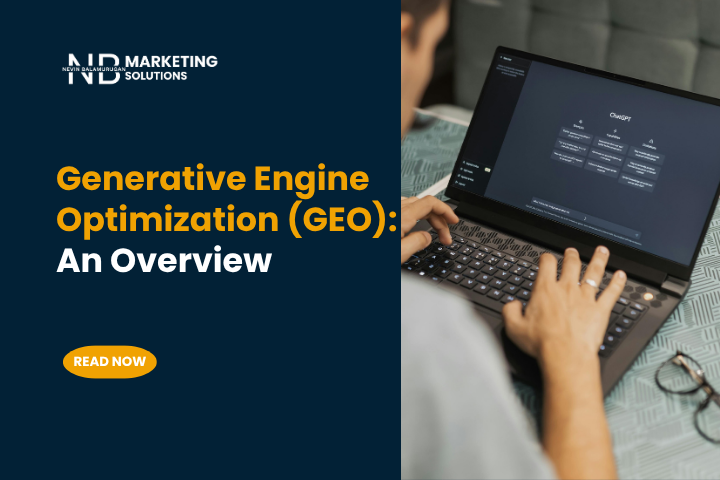Generative Engine Optimization (GEO): What You Need To Know in 2025
Abirami Dharmalingam
October 9, 2025

Generative Engine Optimization (GEO) | An Overview in 2025
The rules of search are changing. Generative engine optimization (GEO) is an important new factor in search. Today, AI-driven search engines like ChatGPT, Google AI Overviews, and Perplexity are answering each question before people click on the top-ranking website content.
So, if you ignore this shift because your SEO dashboard still looks decent, you’ll miss your customers who are searching for niche-related information in AI search. Over 58% of customers now rely on Gen AI search for product or service recommendations, more than double 25% in 2023. Most clicks are not happening outside; they’re happening inside the answer box.
If you want to stay visible, you need to work for both GEO and search engine optimization (SEO).
TABLE OF CONTENTS
- What is Generative Engine Optimization (GEO)?
- Why is Generative Engine Optimization Important?
- GEO vs SEO: Difference
- Best Practices for Optimizing Your Content for GEO
- Generative Engine Optimization FAQs

What is Generative Engine Optimization (GEO)?
Generative engine optimization is the practice of optimizing content to appear in AI search engines and answer engines that use large language models (LLMs) to generate conversational responses. You can enhance your content visibility in AI-powered platforms like ChatGPT, Perplexity, Claude, and Google’s AI Overviews.
You may know that search engine optimization (SEO) focuses on ranking high in search engine result pages (SERPs) with the use of Google’s ranking algorithm. But AI platforms don’t work like SEO. They combine semantic search with LLMs to generate conversational responses from relevant sources they trust. They give you answers rather than showing a list of website links.
Why is Generative Engine Optimization Important?
While Google dominates 90% of the search engine market, it’s still facing competition from AI search platforms like ChatGPT, where customers send 2.5 million prompts each day.
Today, AI-powered results are part of search. Google’s AI Overviews, Bing’s Copilot, and AI platforms like ChatGPT, Perplexity, and Claude deliver answers for your queries. So, customers often don’t click website links.
So, structure your content correctly so AI platforms can cite your content with a link. By this, you can get visibility even if customers never see your website content on the top-ranking search result pages.
Here are some benefits of implementing GEO:
- Increased visibility: By optimizing your content, generative engines can provide your source of information for your customers’ queries, which leads to brand awareness and organic traffic to your website.
- Attract high-intent customers: Mostly, AI searchers demonstrate stronger purchase intent. With the detailed questions, customers expect all-in-one answers that enhance higher conversion rates.
- Enhanced search behavior: 46% of Gen Z and 35% of Millennials prefer Instagram, TikTok, and other social platforms instead of Google. Customers look for conversational content; they want accurate answers to their queries. By optimizing your content for GEO, they can find exactly what they are looking for with less effort.
- Future-proof visibility: ChatGPT serves over 800 million users per week, Perplexity gets 100 million searches per week, Claude gets over 18.9 million users per month, and so on. So, marketers who adopt generative engine optimization can be well-positioned in the AI search.
- Enhanced brand visibility: Citing your website link in the top-ranking pages is good. But, cited by AI search engines acts as a third-party endorsement, building trust faster than traditional search engines.
GEO vs SEO: Difference
Look at the table below to find out the difference between GEO vs SEO. The distinctions between GEO and SEO reveal why you need specific-platform strategies.
| ASPECT | GEO | SEO |
| Primary goal | Appear in AI-generated responses | Get organic ranking in the SERPs |
| Platform focus | AI-driven search engines (Copilot, AI Overviews) and Gen AI tools (ChatGPT, Perplexity, Claude, Gemini) | Traditional search engines (Google, Bing, Yahoo) |
| Output format | Synthesized conversational response | List of website links |
| Optimization strategy | Focuses on structure, clarity, entity-based content, and factual accuracy. | Focuses on keyword research, backlinks, meta tags, technical SEO, and page authority. |
| User interaction | Conversational prompts | Short or long tail keywords |
| Content structure | Scannable lists | Keyword-focused paragraph |
| Key metrics | Appears in AI responses, brand mentions, and AI-driven traffic or conversion. | Ranking, Impressions, CTR (click-through rate) |
| Role of credibility | Values authoritative and sources | Values EEAT (Experience, Expertise, Authoritativeness, Trustworthiness) |
| Challenges | Lack of tracking tools, unclear ranking criteria | Algorithm fluctuations, high competition |
Best Practices for Optimizing Your Content For GEO
Firstly, you need to understand the process of generative AI so that you can gain knowledge to create content that resonates with both humans and AI. Moreover, we’ve some strategies that you need to use to influence LLMs to show your brand in the AI search results.
With these techniques, you can incorporate them into your content strategy today to generate LLM-oriented results:
1. Write the way people talk
To be more specific, generative engine optimization loves conversational tone content. Unlike Google searches, where customers type short, keyword-focused phrases, customers now ask complete questions when interacting with tools like ChatGPT, Gemini, or Perplexity.
To make sense, think about when was the last time you typed “best marketing AI tools 2025”?
Maybe years before, now customers love something more natural like, “What are the best AI tools for digital marketing in 2025?”
So, if you want your content to show up in AI-generated responses, you need to start writing the way people actually talk.
- Use long-tail conversational phrases rather than keyword-stuffed content.
- Write in clear way because AI looks for straightforward and scannable content. So, break your longer paragraphs into shorter.
- Use bullet points where necessary for crisp explanations.
2. Use Multimodal content
If you think AI platforms only pull information from blogs and articles — think again. The way customers consume content has evolved, and generative search engines show text with references from insights like videos, podcasts, and infographics, which helps them deliver a complete answer.
So don’t limit your expertise to only text. The rules of search are changing. If your content is limited only to blogs and articles, you’re missing content across multiple formats that includes short-form videos, audio clips, and visual data.
Today, customers watch a 60-second video that provides a better view than a 1,000-word article. So, start diversifying how you present your content.
- Create short videos that highlight key takeaways from your articles.
- Add infographics, data charts, or flow diagrams to refer to content visually.
- Use metadata, alt text, structured data, and transcripts to understand what non-text content says.
3. Include quotes, clear statements, and statistics
When it comes to optimizing for generative SEO, clarity is important. AI platforms love content that includes direct statements, statistics, and quotable insights, which helps your content to be easily cited and summarized.
4. Create well-structured content
AI models interpret content from top to bottom, so a clear hierarchy helps them understand both the context and the intent of your page. If your content is messy or poorly organized, AI may struggle to identify the key points, which reduces your chances in AI responses.
So, start with a descriptive H1 title that clearly conveys the main idea of your content and addresses the primary user intent. This is the first signal AI looks at, so it should summarize what your page is about concisely.
Next, break down your topic using subheadings (H2 and H3). These subheadings help to extract answers to specific questions. They also improve readability for your human audience. The more naturally your content flows, the better it can understand and reference your information.
Look at the example for this current article, which is perfectly optimized:
H1 – Generative Engine Optimization (GEO) | A Complete Overview in 2025: It provides a general overview and sets the main intent.
H2 – What is Generative Engine Optimization?: This outlines what the blog is speaking about.
H3 – Why GEO is important, GEO vs SEO, and Best Practices: explains each element in detail.
By following this top-down approach, GEO can quickly identify whether your content is relevant to a user’s query and then give granular answers.
Use GEO to Appear in AI Responses Today
Generative Engine Optimization (GEO) is the new standard for brand visibility. Follow these best practices to improve your content discoverability and position your brand name in the top-recognized industry.
If you look for more valuable insights, marketing strategies, and guidance on marketing in this AI era, follow NB Marketing Solutions to stay ahead in digital marketing.
Generative Engine Optimization FAQs
1. What is GEO?
GEO stands for Generative Engine Optimization. It optimizes your content for AI search engines and AI platforms like ChatGPT, Gemini, Perplexity, AI Overviews, and Copilot.
2. How is GEO different from SEO?
SEO focuses on top ranking SERPs, while GEO focuses on conversational content optimized for AI search engines.
3. Should I need to include quotes and statistics for GEO?
Yes, you can include quotes, facts, clear statements, and statistics because AI favors verifiable statements, expert quotes, and data-backed insights for credibility.
4. Does content format matter for GEO?
Yes, these AI platforms not only optimize text, but they also optimize videos, infographics, charts, and audio clips.
5. Do I need to optimize technical SEO for GEO?
Yes, Technical SEO matters in GEO. Use a fast-loading, mobile-friendly design, proper URLs, and schema markup to help AI crawl and index your site.
Recent Posts
Have Any Question?
- (+91) 938-542-1049
- info@nbmarketingsolutions.in
Categories
Make Appointment
Confused Over Choosing The Right Services For Your Business?
Tamil Nadu, India
- Near TMB Bank, Anjugramam post, Kanyakumari 629401
- info@nbmarketingsolutions.in
- (+91)93-8542-1049
